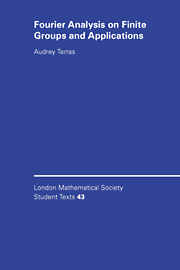Book contents
- Frontmatter
- Contents
- Preface
- Part I Finite Abelian Groups
- 1 Congruences and the Quotient Ring of the Integers mod n
- 2 The Discrete Fourier Transform on the Finite Circle ℤ/nℤ
- 3 Graphs of ℤ/nℤ, Adjacency Operators, Eigenvalues
- 4 Four Questions about Cayley Graphs
- 5 Finite Euclidean Graphs and Three Questions about Their Spectra
- 6 Random Walks on Cayley Graphs
- 7 Applications in Geometry and Analysis. Connections between Continuous and Finite Problems. Dido's Problem for Polygons
- 8 The Quadratic Reciprocity Law
- 9 The Fast Fourier Transform or FFT
- 10 The DFT on Finite Abelian Groups – Finite Tori
- 11 Error-Correcting Codes
- 12 The Poisson Sum Formula on a Finite Abelian Group
- 13 Some Applications in Chemistry and Physics
- 14 The Uncertainty Principle
- Part II Finite Nonabelian Groups
- References
- Index
9 - The Fast Fourier Transform or FFT
from Part I - Finite Abelian Groups
Published online by Cambridge University Press: 06 July 2010
- Frontmatter
- Contents
- Preface
- Part I Finite Abelian Groups
- 1 Congruences and the Quotient Ring of the Integers mod n
- 2 The Discrete Fourier Transform on the Finite Circle ℤ/nℤ
- 3 Graphs of ℤ/nℤ, Adjacency Operators, Eigenvalues
- 4 Four Questions about Cayley Graphs
- 5 Finite Euclidean Graphs and Three Questions about Their Spectra
- 6 Random Walks on Cayley Graphs
- 7 Applications in Geometry and Analysis. Connections between Continuous and Finite Problems. Dido's Problem for Polygons
- 8 The Quadratic Reciprocity Law
- 9 The Fast Fourier Transform or FFT
- 10 The DFT on Finite Abelian Groups – Finite Tori
- 11 Error-Correcting Codes
- 12 The Poisson Sum Formula on a Finite Abelian Group
- 13 Some Applications in Chemistry and Physics
- 14 The Uncertainty Principle
- Part II Finite Nonabelian Groups
- References
- Index
Summary
It [the FFT] also dominates the search for offshore oil. Water layers produce “ringing” that masks the signals from oil or gas; those primary reflections could not be seen before 1960. Now virtually all exploration data is digital and more than 109 systems of equations are solved every year – partly by the FFT and partly by Levinson's algorithm for constant-diagonal (Toeplitz) matrices. The key problem is deconvolution…
Strang [1986, p. 467].Despite a fear of oil slicks on the beach in Encinitas, we want to sketch the theory of the fast Fourier transform or FFT. The simplest version of this transform allows one to compute the DFT on a finite cyclic group of order n = 2k elements in n log w operations rather than n2 operations. Other algorithms exist if n is not a power of 2 but we will not discuss them here. The FFT has revolutionized digital signal processing.
We are mostly following the discussion in G. Strang [1986]. The FFT is usually attributed to Cooley and Tukey [1965]. However, Heidemann et al. [1984] note that the Cooley-Tukey algorithm was essentially known to Gauss in 1805, which is two years before Fourier and 160 years before Cooley and Tukey.
Brigham [1974] says that R. L. Garwin asked Tukey to give him a rapid way to compute the Fourier transform during a meeting of the President's Scientific Advisory Committee.
- Type
- Chapter
- Information
- Fourier Analysis on Finite Groups and Applications , pp. 151 - 160Publisher: Cambridge University PressPrint publication year: 1999
- 2
- Cited by

